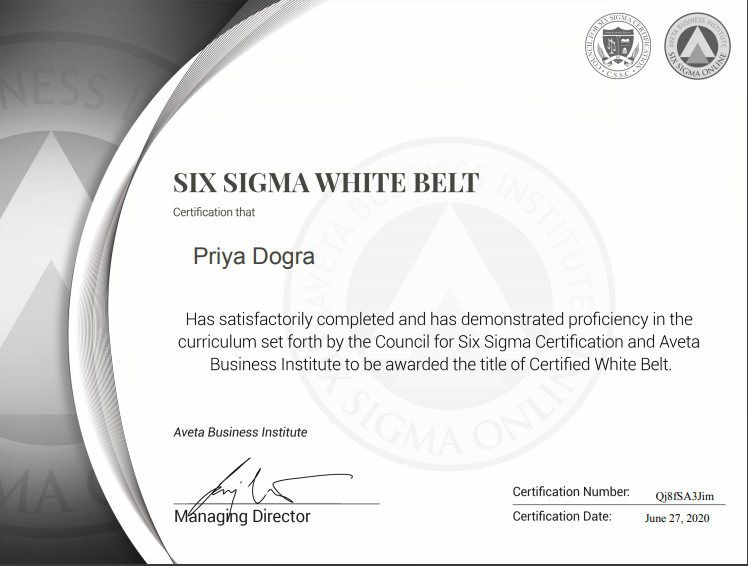GET CERTIFICATION: Six Sigma White Belt Training & Certification

QUESTION 1: Six Sigma:
A. ultimately reduces process costs
B. decreases customer satisfaction
C. is a methodology for process improvement
D. is a statistical concept that seeks to find variation in processes
E. all of the above
F. some of the above
QUESTION 2: What do Data driven processes mean?
A. are heavily based on intuition
B. rely heavily on the experience of the process owners
C. are based on statistical data, measurement and metrics
D. do NOT rely on mathematical models
QUESTION 3: Beta testing is the act of implementing a new idea, system or product on a large scale, controlled environment within the entire organization.
A. True
B. False
QUESTION 4: A process that performs at a 6 sigma level:
A. is considered statistically ‘perfect’
B. has 3.4 defects per million opportunities
C. operates at a 99.99966% accuracy
D. all of the above
QUESTION 5: The statistical difference between a process operating at a 5 sigma level and a process operating at a 6 sigma level is markedly different when it comes to the number of defects present.
A. True
B. False
QUESTION 6: A Six Sigma level is calculated by which of the following equations:
A. (Opportunities – Defects)/Opportunities x 100
B. (Opportunities + Defects)/Opportunities x 100
C. (Defects – Opportunities)/Defects x 100
D. (Defects + Opportunities)/Defects x 100
QUESTION 7: When prioritizing Six Sigma projects within an organization:
A. The project with the statistically lowest sigma level should always be prioritized
B. The project with the highest potential cost savings should always be prioritized.
C. The project with the highest potential customer satisfaction increase should always be prioritized.
D. All of the above should be considered and statistically researched before choosing the best option for the organization at hand.
QUESTION 8: What does the Value Stream mean?
A. is the sequence of all items, events and people required to produce an end result.
B. is used to identify areas of concern, waste and improvement.
C. Neither A nor B
D. Both A and B
QUESTION 9: An organization that fully adopts the Six Sigma methodology:
A. completes a few Six Sigma Projects and reaps the financial benefits
B. continuously measures and improves processes indefinitely
C. improves upon a few processes then moves on
D. identifies and prioritizes areas of opportunity once or twice a year
QUESTION 10: Which of the following is NOT an example of a common challenge of the Six Sigma Methodology within an organization?
A. lack of support
B. poor project execution
C. excess resources
D. lack of access to data
QUESTION 11: Which of the following is NOT an end goal of BOTH quality improvement programs and continuous process improvement?
A. Achieving a specific set goal
B. Reducing errors and defects
C. Improving efficiency
D. Improving profits
QUESTION 12: Six Sigma Teams use the ________ method when improving a product or process that already exists, and the ________ method when developing a new product or process.
A. DMAAC, DMAAV
B. DMAAV, DMAAC
C. DMAIC, DMADV
D. DMADV, DMAIC
QUESTION 13: Errors and costs ________ as sigma levels ________.
A. increase, increase
B. increase, decrease
C. decrease, decrease
QUESTION 14: Order the correct steps of the Demming Cycle:
A. Plan, Do, Check, Act
B. Plan, Act, Do, Check
C. Act, Do, Check, Plan
D. Plan, Check, Do, Act
QUESTION 15: The Motorola Company is credited with the origin of the Six Sigma Methodology.
A. True
B. False
QUESTION 16: Which of the following is considered the father of Six Sigma?
A. Jack Welch
B. Mikel Harry
C. Richard Schroeder
D. Bob Galvin
QUESTION 17: Which of the following is NOT a common misconception of the Six Sigma Methodology?
A. Six Sigma can fix anything.
B. Six Sigma is too expensive.
C. Six Sigma is concerned with metrics and ignores common sense.
D. Six Sigma aims to reduce defects in hopes of increasing profitability.
QUESTION 18: Which of the following correctly orders the Six Sigma Certification Belt levels from lowest to highest?
A. Green, Master Black, Yellow, White
B. Master Black, Black, Green, Yellow, White
C. White, Yellow, Green, Black, Master Black
D. White, Yellow Black, Master Black, Green
QUESTION 19: Which of the following is NOT a component of Six Sigma Yellow Belt Training?
A. Advanced Project and Team Management Skills
B. Data collection
C. Basic Quality Tools
D. Six Sigma Roles
QUESTION 20: Which of the following Belt Levels usually require a Six Sigma Project be completed before a Six Sigma Certification is awarded?
A. White Belt
B. Yellow Belt
C. Green Belt
D. Black Belt
E. Master Black Belt
F. None of the Above
G. All of the above
H. Some of the above
QUESTION 21: Lean principles often go hand-in-hand with Six Sigma principles.
A. True
B. False
QUESTION 22: Which of the following is NOT a similarity between Lean and Six Sigma concepts?
A. They are both concerned with continuous improvement.
B. They both seek to increase instances of waste within an organization.
C. They are both concerned with an overall culture of quality rather than single events that increase quality and decrease defects.
QUESTION 23: Which of the following is NOT a key element of TQM (Total Quality Management) initiatives?
A. Teamwork
B. Ethics
C. Integrity
D. Ingenuity
QUESTION 24: According to the TQM mentality, the entire organization is only as strong as the ________ element.
A. strongest
B. weakest
C. least productive
D. most productive
QUESTION 25: Which of the following is NOT a continuous process improvement technique?
A. Six Sigma Methodologies
B. Lean
C. TQM (Total Quality Management)
D. BPR (Business Process Reengineering)
QUESTION 26: Which of the following methods seeks to effect positive change in processes and organizations by using a set of practical tools to address business issues and process problems?
A. BPR (Business Process Reengineering)
B. TQM (Total Quality Management)
C. Rummler-Brache
D. Six Sigma Methodologies
E. Lean
F. This statement can apply to more than one of the above.
QUESTION 27: Which of the following shows phases of the Rummler-Brache Method in the correct order?
A. Definition, Implementation, Improvement Planning, Management of Process
B. Definition, Improvement Planning, Implementation
C. Improvement Planning, Definition, Analysis and Design, Implementation, Management of Process
D. Definition, Improvement Planning, Analysis and Design, Implementation, Management of Process
QUESTION 28: Scrum is used:
A. When teams want to create new technical products
B. when teams want to integrate new developments on existing products within a short time frame
C. All of the above
D. None of the above
QUESTION 29: True or False: Jumpstart is a fast-paced method for identifying problems and solutions in a single session that can be used within other methods such as Rummler-Brache, Scrum, and TQM.
A. True
B. False
QUESTION 30: The Six Sigma process improvement method should be chosen when:
A. facing a known problem
B. problems are defined and contained
C. solving complex problems
D. costs are loosely tied to processes.
 Priya Dogra – Certification | Jobs | Internships
Priya Dogra – Certification | Jobs | Internships




 Goldman Sachs Summer Analyst Internship 2025 – India | Applications Open July 1
Goldman Sachs Summer Analyst Internship 2025 – India | Applications Open July 1
Thanks for the Six Sigma white belt certification answers. All are 100% Coreect.
love you for all your hard work
YOU ARE THE BEST!!!!!!
I’m really impressed with your writing skills and also with the format on your weblog. Is that this a paid theme or did you modify it yourself? Either way stay up the nice high quality writing, it is rare to peer a nice weblog like this one these days.